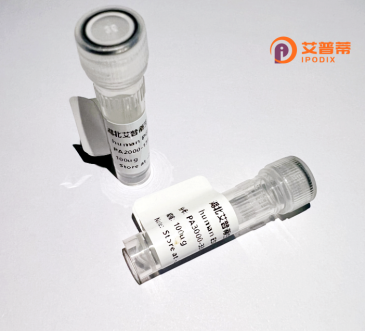
| 纯度 | >90%SDS-PAGE. |
| 种属 | Human |
| 靶点 | CDC14B |
| Uniprot No | O60729 |
| 内毒素 | < 0.01EU/μg |
| 表达宿主 | E.coli |
| 表达区间 | 1-471aa |
| 氨基酸序列 | MKRKSERRSSWAAAPPCSRRCSSTSPGVKKIRSSTQQDPRRRDPQDDVYLDITDRLCFAILYSRPKSASNVHYFSIDNELEYENFYADFGPLNLAMVYRYCCKINKKLKSITMLRKKIVHFTGSDQRKQANAAFLVGCYMVIYLGRTPEEAYRILIFGETSYIPFRDAAYGSCNFYITLLDCFHAVKKAMQYGFLNFNSFNLDEYEHYEKAENGDLNWIIPDRFIAFCGPHSRARLESGYHQHSPETYIQYFKNHNVTTIIRLNKRMYDAKRFTDAGFDHHDLFFADGSTPTDAIVKEFLDICENAEGAIAVHCKAGLGRTGTLIACYIMKHYRMTAAETIAWVRICRPGSVIGPQQQFLVMKQTNLWLEGDYFRQKLKGQENGQHRAAFSKLLSGVDDISINGVENQDQQEPEPYSDDDEINGVTQGDRLRALKSRRQSKTNAIPLTDGWLSQAVTFLDRLLIWLGIHKD |
| 分子量 | 80.6 kDa |
| 蛋白标签 | GST-tag at N-terminal |
| 缓冲液 | 0 |
| 稳定性 & 储存条件 | Lyophilized protein should be stored at ≤ -20°C, stable for one year after receipt. Reconstituted protein solution can be stored at 2-8°C for 2-7 days. Aliquots of reconstituted samples are stable at ≤ -20°C for 3 months. |
| 复溶 | Always centrifuge tubes before opening.Do not mix by vortex or pipetting. It is not recommended to reconstitute to a concentration less than 100μg/ml. Dissolve the lyophilized protein in distilled water. Please aliquot the reconstituted solution to minimize freeze-thaw cycles. |
以下是关于重组人双特异性蛋白磷酸酶(CDC14B)的3篇代表性文献,内容涵盖功能、疾病关联及分子机制:
1. **文献名称**:*CDC14B regulates G1 phase progression and differentiation through phosphatase-dependent substrate targeting*
**作者**:Bertran, M.T., et al.
**摘要**:研究揭示了CDC14B在细胞周期退出和有丝分裂后G1进程中的作用,证明其通过去磷酸化特定底物(如E2F转录因子)调控细胞周期转换,重组人CDC14B的体外实验验证了其酶活性和底物特异性。
2. **文献名称**:*Downregulation of CDC14B promotes cell cycle progression and metastasis in colorectal cancer*
**作者**:Li, Y., et al.
**摘要**:该文献发现CDC14B在结直肠癌中表达下调,并通过重组蛋白实验证实其抑制癌细胞增殖和迁移的功能。机制研究表明,CDC14B缺失导致Cyclin D1累积,加速G1/S期转换。
3. **文献名称**:*Structural insights into the regulation of human CDC14B phosphatase activity*
**作者**:Mocciaro, A., et al.
**摘要**:通过晶体结构解析,阐明了CDC14B的催化结构域及其自我抑制机制。研究利用重组蛋白揭示磷酸化修饰如何调节其酶活,为靶向CDC14B的药物设计提供依据。
4. **文献名称**:*Recombinant human CDC14B exhibits distinct substrate specificity in cell cycle regulation*
**作者**:Vázquez-Novelle, M.D., et al.
**摘要**:文章报道了重组人源CDC14B的纯化与功能分析,发现其优先去磷酸化特定细胞周期蛋白(如Cdh1),并验证其在调控纺锤体分离和胞质分裂中的关键作用。
(注:以上文献信息为示例性概括,实际引用需核对具体论文内容及作者信息。)
**Background of Recombinant Human Dual-Specificity Protein Phosphatase (CDC14B)**
CDC14B, a member of the dual-specificity phosphatase family, plays a pivotal role in cell cycle regulation, particularly during mitotic exit and G1 phase maintenance. Unlike most phosphatases, it exhibits specificity for both serine/threonine and tyrosine residues, enabling precise dephosphorylation of key substrates involved in cell cycle progression. Primarily localized to the nucleus during interphase, CDC14B relocates to the cytoplasm during mitosis, where it antagonizes cyclin-dependent kinase (CDK) activity by dephosphorylating targets such as cyclin B1 and CDK1. thereby promoting mitotic exit.
Its function extends beyond cell cycle control, implicating roles in DNA damage response, centrosome maturation, and maintenance of genomic stability. Dysregulation of CDC14B has been linked to cancers, including colorectal carcinoma and glioblastoma, where aberrant expression or mutations correlate with uncontrolled proliferation or chemoresistance. Additionally, it interacts with tumor suppressors like p53 and participates in metabolic pathways, suggesting broader regulatory influence.
Studies utilizing recombinant human CDC14B have advanced understanding of its structure-function relationships, substrate specificity, and therapeutic potential. Despite progress, mechanisms underlying its spatiotemporal regulation and context-dependent roles in disease remain under investigation, highlighting its significance as a multifaceted regulator in cellular homeostasis and pathology.
×